An In-Depth Analysis of TESCO's Organisational Behaviour (Report)
VerifiedAdded on 2023/01/03
|12
|2735
|91
Report
AI Summary
This report provides an analysis of the organizational behaviour of TESCO, examining how the company manages its employees through its culture, communication strategies, and motivational approaches. The report delves into the impact of organizational culture, including an examination of Handy's culture model and Schein's model. It also explores TESCO's communication strategies, including the application of various communication theories and models, such as Aristotle's and Hoveland's persuasion models. Furthermore, the report investigates TESCO's motivational techniques, including the application of Maslow's hierarchy of needs and Vroom's expectancy theory, to understand how the company encourages its employees to achieve organizational goals. The report concludes by summarizing the key findings and their implications for TESCO's overall success. This assignment is a comprehensive overview of the company's internal dynamics.
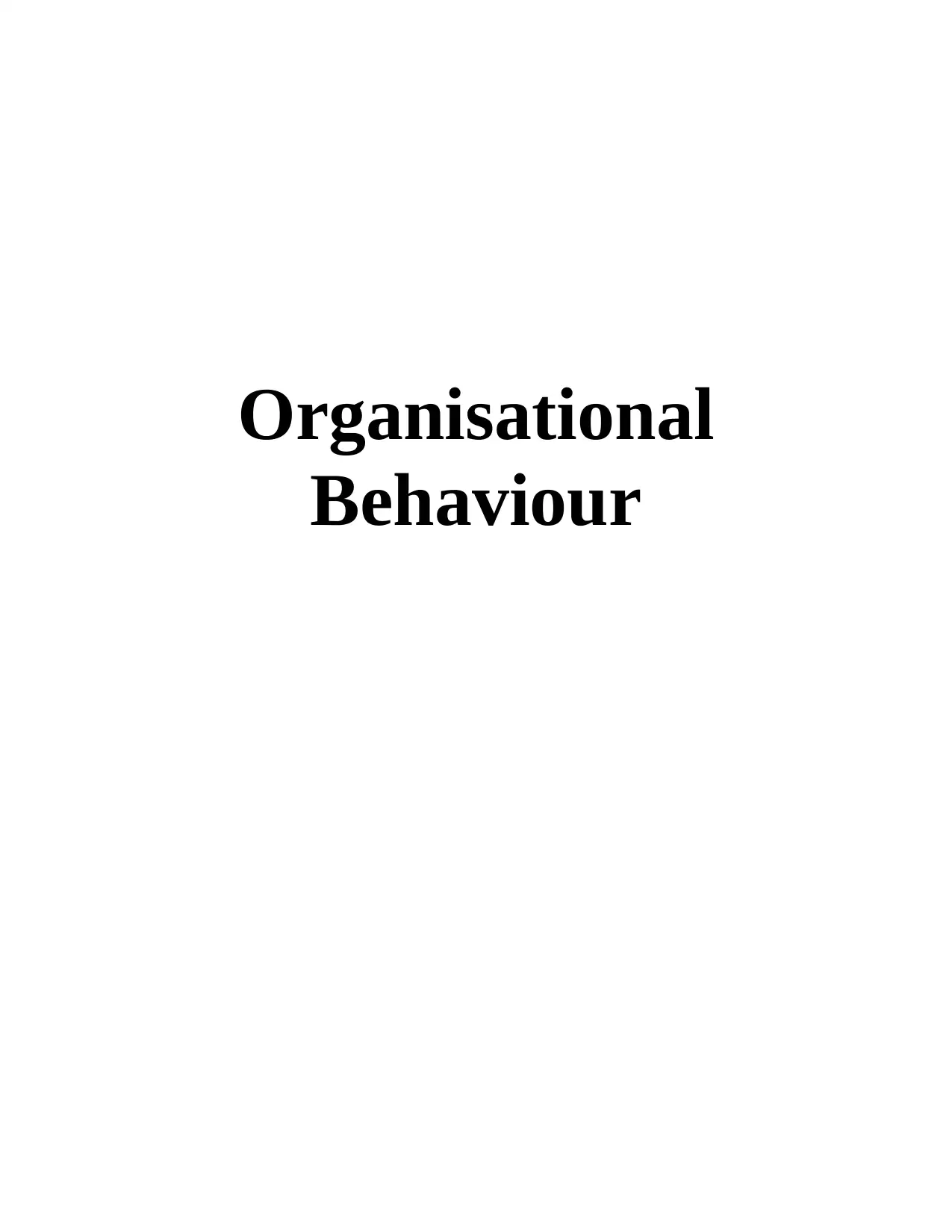
Organisational
Behaviour
Behaviour
Paraphrase This Document
Need a fresh take? Get an instant paraphrase of this document with our AI Paraphraser
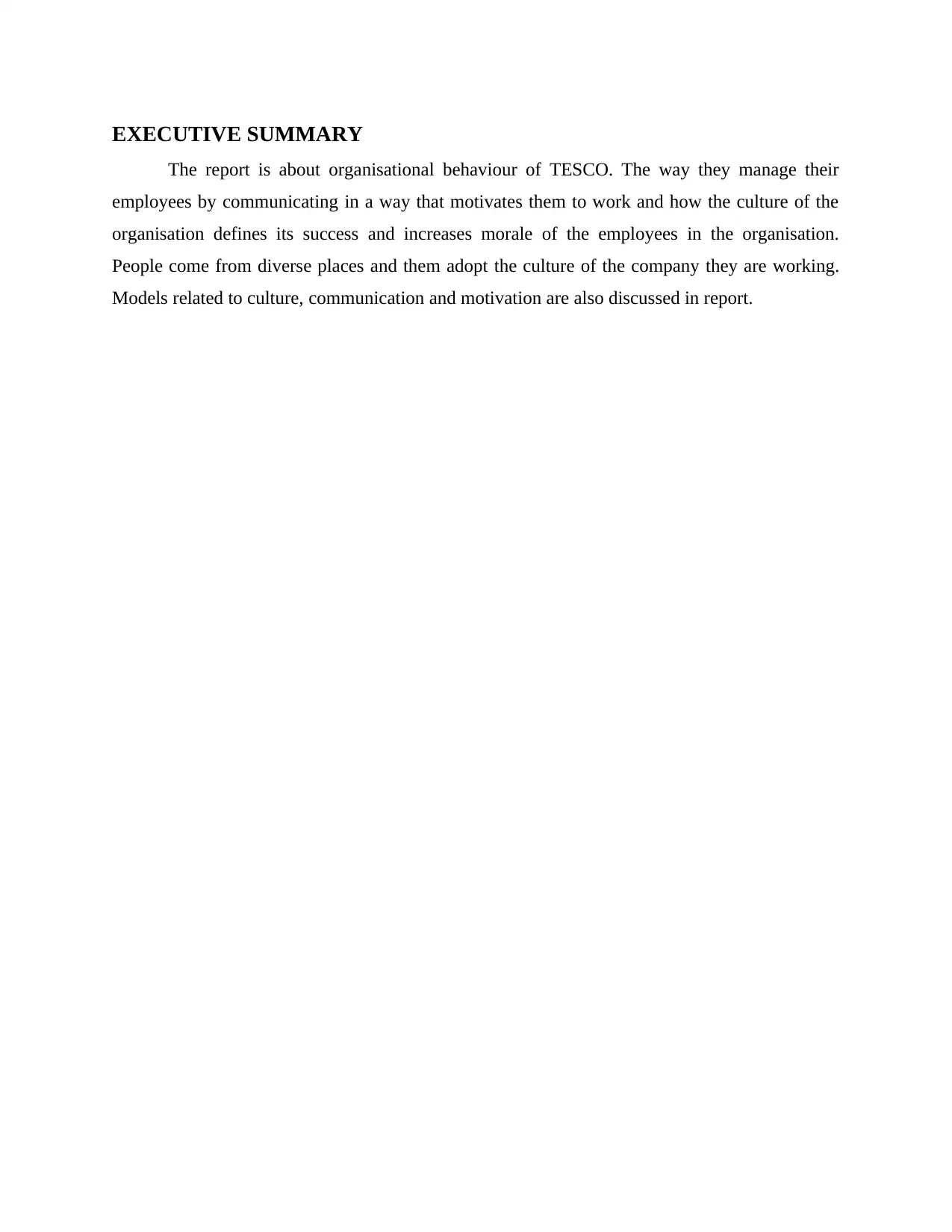
EXECUTIVE SUMMARY
The report is about organisational behaviour of TESCO. The way they manage their
employees by communicating in a way that motivates them to work and how the culture of the
organisation defines its success and increases morale of the employees in the organisation.
People come from diverse places and them adopt the culture of the company they are working.
Models related to culture, communication and motivation are also discussed in report.
The report is about organisational behaviour of TESCO. The way they manage their
employees by communicating in a way that motivates them to work and how the culture of the
organisation defines its success and increases morale of the employees in the organisation.
People come from diverse places and them adopt the culture of the company they are working.
Models related to culture, communication and motivation are also discussed in report.
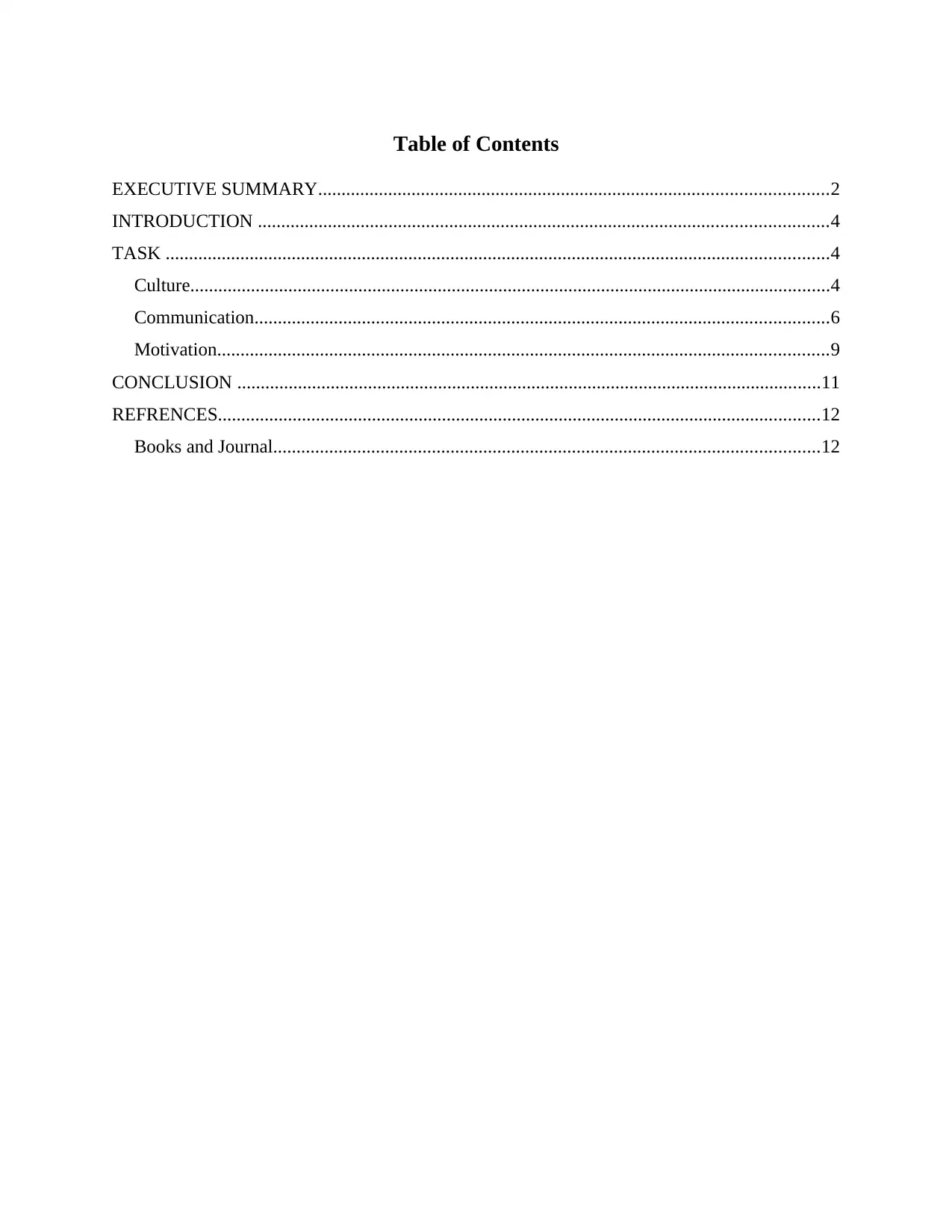
Table of Contents
EXECUTIVE SUMMARY.............................................................................................................2
INTRODUCTION ..........................................................................................................................4
TASK ..............................................................................................................................................4
Culture.........................................................................................................................................4
Communication...........................................................................................................................6
Motivation...................................................................................................................................9
CONCLUSION .............................................................................................................................11
REFRENCES.................................................................................................................................12
Books and Journal.....................................................................................................................12
EXECUTIVE SUMMARY.............................................................................................................2
INTRODUCTION ..........................................................................................................................4
TASK ..............................................................................................................................................4
Culture.........................................................................................................................................4
Communication...........................................................................................................................6
Motivation...................................................................................................................................9
CONCLUSION .............................................................................................................................11
REFRENCES.................................................................................................................................12
Books and Journal.....................................................................................................................12
⊘ This is a preview!⊘
Do you want full access?
Subscribe today to unlock all pages.

Trusted by 1+ million students worldwide
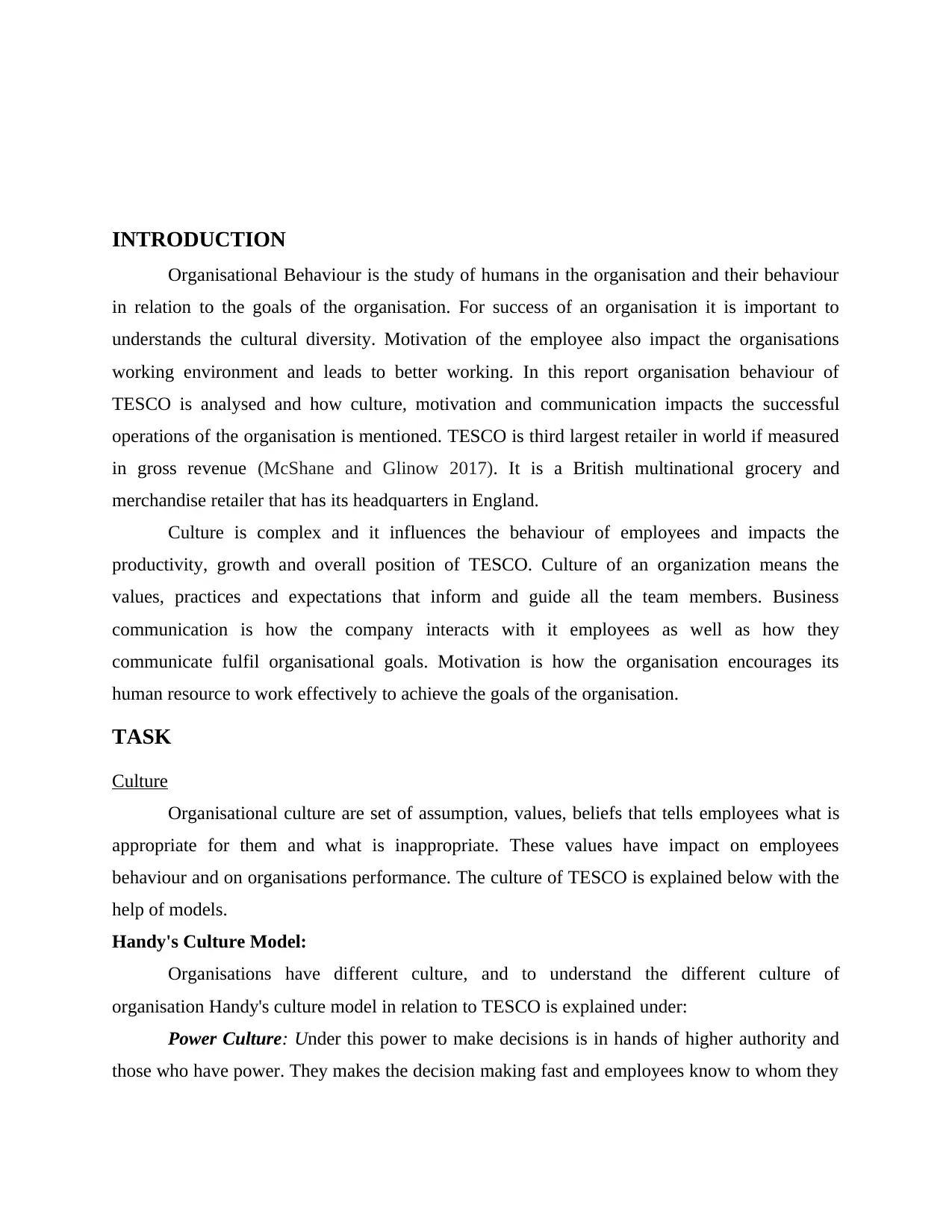
INTRODUCTION
Organisational Behaviour is the study of humans in the organisation and their behaviour
in relation to the goals of the organisation. For success of an organisation it is important to
understands the cultural diversity. Motivation of the employee also impact the organisations
working environment and leads to better working. In this report organisation behaviour of
TESCO is analysed and how culture, motivation and communication impacts the successful
operations of the organisation is mentioned. TESCO is third largest retailer in world if measured
in gross revenue (McShane and Glinow 2017). It is a British multinational grocery and
merchandise retailer that has its headquarters in England.
Culture is complex and it influences the behaviour of employees and impacts the
productivity, growth and overall position of TESCO. Culture of an organization means the
values, practices and expectations that inform and guide all the team members. Business
communication is how the company interacts with it employees as well as how they
communicate fulfil organisational goals. Motivation is how the organisation encourages its
human resource to work effectively to achieve the goals of the organisation.
TASK
Culture
Organisational culture are set of assumption, values, beliefs that tells employees what is
appropriate for them and what is inappropriate. These values have impact on employees
behaviour and on organisations performance. The culture of TESCO is explained below with the
help of models.
Handy's Culture Model:
Organisations have different culture, and to understand the different culture of
organisation Handy's culture model in relation to TESCO is explained under:
Power Culture: Under this power to make decisions is in hands of higher authority and
those who have power. They makes the decision making fast and employees know to whom they
Organisational Behaviour is the study of humans in the organisation and their behaviour
in relation to the goals of the organisation. For success of an organisation it is important to
understands the cultural diversity. Motivation of the employee also impact the organisations
working environment and leads to better working. In this report organisation behaviour of
TESCO is analysed and how culture, motivation and communication impacts the successful
operations of the organisation is mentioned. TESCO is third largest retailer in world if measured
in gross revenue (McShane and Glinow 2017). It is a British multinational grocery and
merchandise retailer that has its headquarters in England.
Culture is complex and it influences the behaviour of employees and impacts the
productivity, growth and overall position of TESCO. Culture of an organization means the
values, practices and expectations that inform and guide all the team members. Business
communication is how the company interacts with it employees as well as how they
communicate fulfil organisational goals. Motivation is how the organisation encourages its
human resource to work effectively to achieve the goals of the organisation.
TASK
Culture
Organisational culture are set of assumption, values, beliefs that tells employees what is
appropriate for them and what is inappropriate. These values have impact on employees
behaviour and on organisations performance. The culture of TESCO is explained below with the
help of models.
Handy's Culture Model:
Organisations have different culture, and to understand the different culture of
organisation Handy's culture model in relation to TESCO is explained under:
Power Culture: Under this power to make decisions is in hands of higher authority and
those who have power. They makes the decision making fast and employees know to whom they
Paraphrase This Document
Need a fresh take? Get an instant paraphrase of this document with our AI Paraphraser
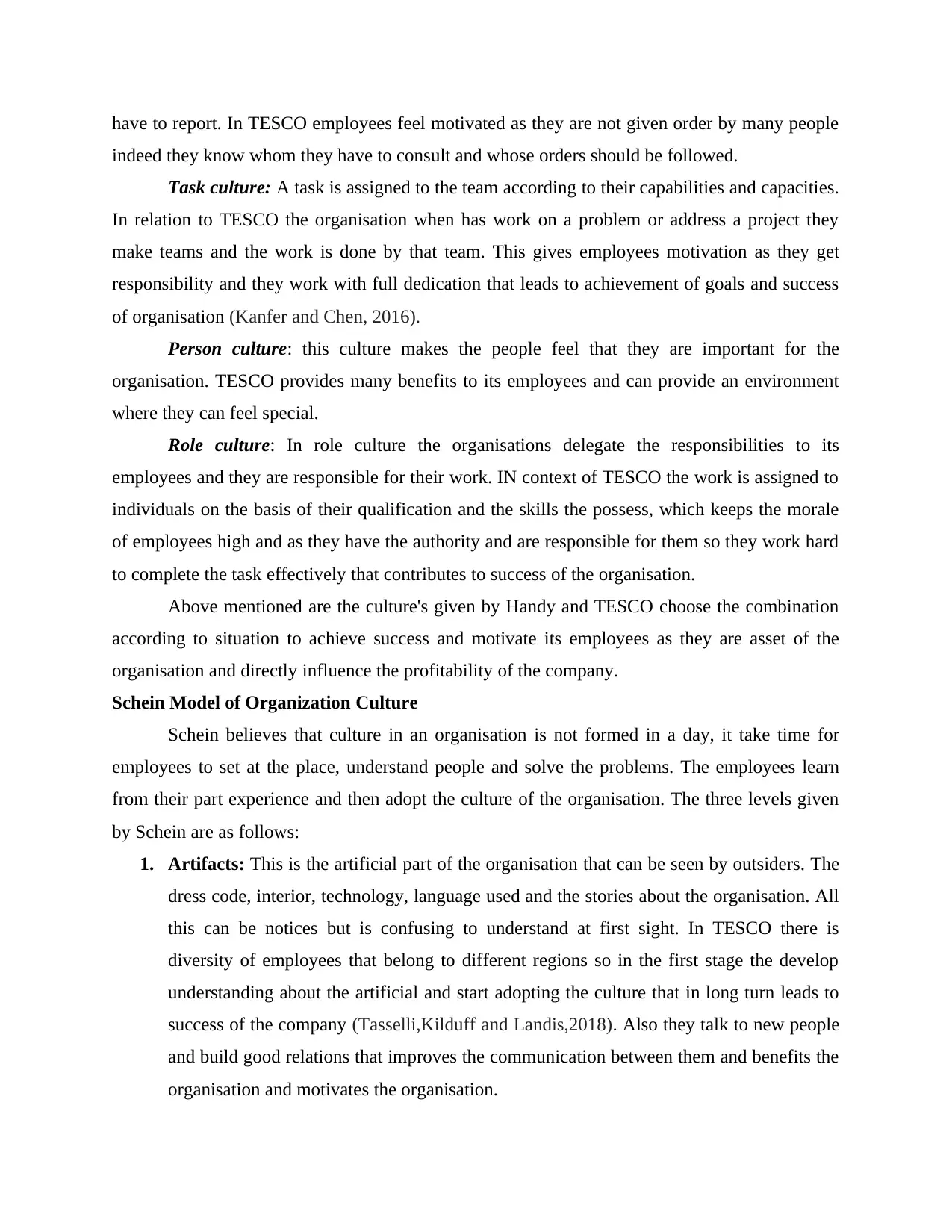
have to report. In TESCO employees feel motivated as they are not given order by many people
indeed they know whom they have to consult and whose orders should be followed.
Task culture: A task is assigned to the team according to their capabilities and capacities.
In relation to TESCO the organisation when has work on a problem or address a project they
make teams and the work is done by that team. This gives employees motivation as they get
responsibility and they work with full dedication that leads to achievement of goals and success
of organisation (Kanfer and Chen, 2016).
Person culture: this culture makes the people feel that they are important for the
organisation. TESCO provides many benefits to its employees and can provide an environment
where they can feel special.
Role culture: In role culture the organisations delegate the responsibilities to its
employees and they are responsible for their work. IN context of TESCO the work is assigned to
individuals on the basis of their qualification and the skills the possess, which keeps the morale
of employees high and as they have the authority and are responsible for them so they work hard
to complete the task effectively that contributes to success of the organisation.
Above mentioned are the culture's given by Handy and TESCO choose the combination
according to situation to achieve success and motivate its employees as they are asset of the
organisation and directly influence the profitability of the company.
Schein Model of Organization Culture
Schein believes that culture in an organisation is not formed in a day, it take time for
employees to set at the place, understand people and solve the problems. The employees learn
from their part experience and then adopt the culture of the organisation. The three levels given
by Schein are as follows:
1. Artifacts: This is the artificial part of the organisation that can be seen by outsiders. The
dress code, interior, technology, language used and the stories about the organisation. All
this can be notices but is confusing to understand at first sight. In TESCO there is
diversity of employees that belong to different regions so in the first stage the develop
understanding about the artificial and start adopting the culture that in long turn leads to
success of the company (Tasselli,Kilduff and Landis,2018). Also they talk to new people
and build good relations that improves the communication between them and benefits the
organisation and motivates the organisation.
indeed they know whom they have to consult and whose orders should be followed.
Task culture: A task is assigned to the team according to their capabilities and capacities.
In relation to TESCO the organisation when has work on a problem or address a project they
make teams and the work is done by that team. This gives employees motivation as they get
responsibility and they work with full dedication that leads to achievement of goals and success
of organisation (Kanfer and Chen, 2016).
Person culture: this culture makes the people feel that they are important for the
organisation. TESCO provides many benefits to its employees and can provide an environment
where they can feel special.
Role culture: In role culture the organisations delegate the responsibilities to its
employees and they are responsible for their work. IN context of TESCO the work is assigned to
individuals on the basis of their qualification and the skills the possess, which keeps the morale
of employees high and as they have the authority and are responsible for them so they work hard
to complete the task effectively that contributes to success of the organisation.
Above mentioned are the culture's given by Handy and TESCO choose the combination
according to situation to achieve success and motivate its employees as they are asset of the
organisation and directly influence the profitability of the company.
Schein Model of Organization Culture
Schein believes that culture in an organisation is not formed in a day, it take time for
employees to set at the place, understand people and solve the problems. The employees learn
from their part experience and then adopt the culture of the organisation. The three levels given
by Schein are as follows:
1. Artifacts: This is the artificial part of the organisation that can be seen by outsiders. The
dress code, interior, technology, language used and the stories about the organisation. All
this can be notices but is confusing to understand at first sight. In TESCO there is
diversity of employees that belong to different regions so in the first stage the develop
understanding about the artificial and start adopting the culture that in long turn leads to
success of the company (Tasselli,Kilduff and Landis,2018). Also they talk to new people
and build good relations that improves the communication between them and benefits the
organisation and motivates the organisation.
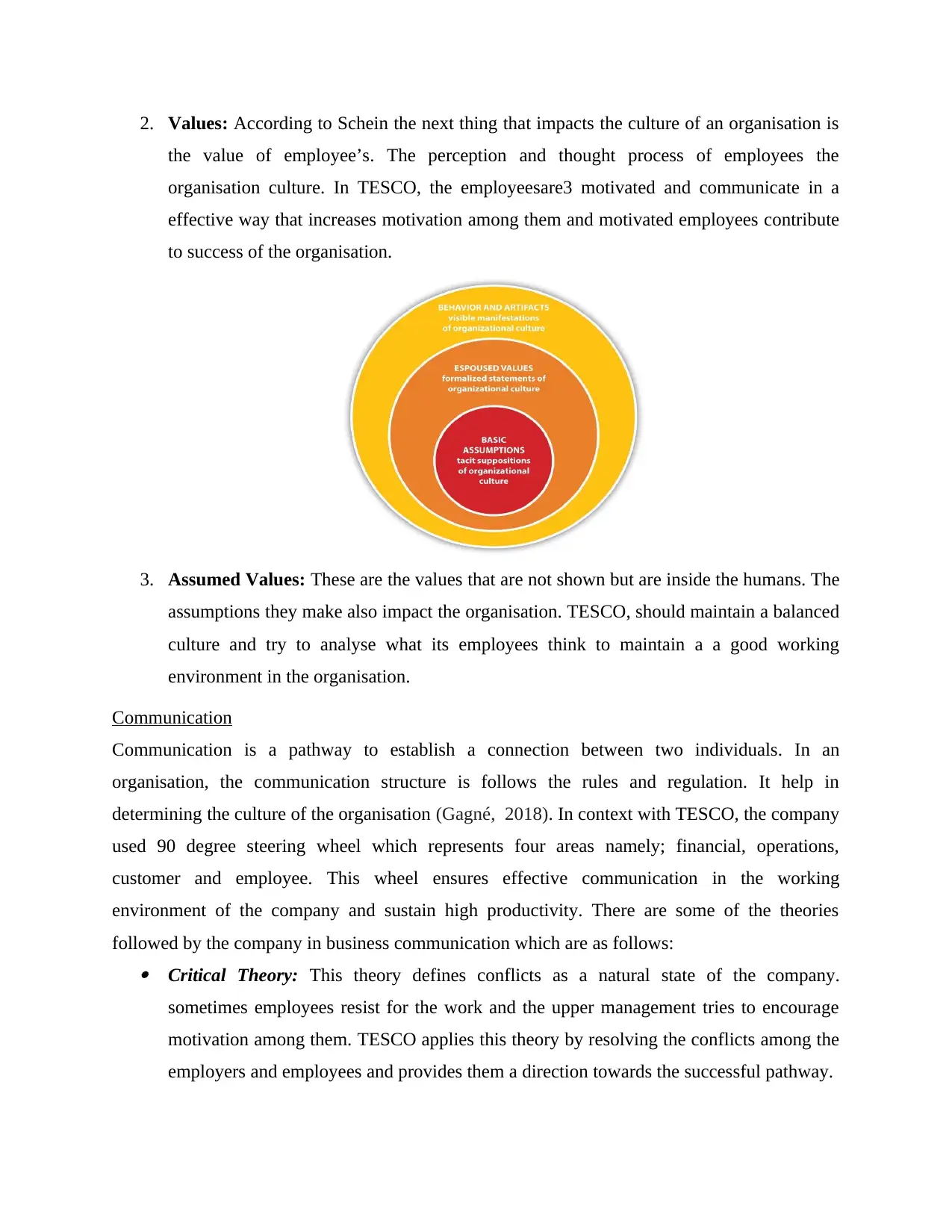
2. Values: According to Schein the next thing that impacts the culture of an organisation is
the value of employee’s. The perception and thought process of employees the
organisation culture. In TESCO, the employeesare3 motivated and communicate in a
effective way that increases motivation among them and motivated employees contribute
to success of the organisation.
3. Assumed Values: These are the values that are not shown but are inside the humans. The
assumptions they make also impact the organisation. TESCO, should maintain a balanced
culture and try to analyse what its employees think to maintain a a good working
environment in the organisation.
Communication
Communication is a pathway to establish a connection between two individuals. In an
organisation, the communication structure is follows the rules and regulation. It help in
determining the culture of the organisation (Gagné, 2018). In context with TESCO, the company
used 90 degree steering wheel which represents four areas namely; financial, operations,
customer and employee. This wheel ensures effective communication in the working
environment of the company and sustain high productivity. There are some of the theories
followed by the company in business communication which are as follows: Critical Theory: This theory defines conflicts as a natural state of the company.
sometimes employees resist for the work and the upper management tries to encourage
motivation among them. TESCO applies this theory by resolving the conflicts among the
employers and employees and provides them a direction towards the successful pathway.
the value of employee’s. The perception and thought process of employees the
organisation culture. In TESCO, the employeesare3 motivated and communicate in a
effective way that increases motivation among them and motivated employees contribute
to success of the organisation.
3. Assumed Values: These are the values that are not shown but are inside the humans. The
assumptions they make also impact the organisation. TESCO, should maintain a balanced
culture and try to analyse what its employees think to maintain a a good working
environment in the organisation.
Communication
Communication is a pathway to establish a connection between two individuals. In an
organisation, the communication structure is follows the rules and regulation. It help in
determining the culture of the organisation (Gagné, 2018). In context with TESCO, the company
used 90 degree steering wheel which represents four areas namely; financial, operations,
customer and employee. This wheel ensures effective communication in the working
environment of the company and sustain high productivity. There are some of the theories
followed by the company in business communication which are as follows: Critical Theory: This theory defines conflicts as a natural state of the company.
sometimes employees resist for the work and the upper management tries to encourage
motivation among them. TESCO applies this theory by resolving the conflicts among the
employers and employees and provides them a direction towards the successful pathway.
⊘ This is a preview!⊘
Do you want full access?
Subscribe today to unlock all pages.

Trusted by 1+ million students worldwide
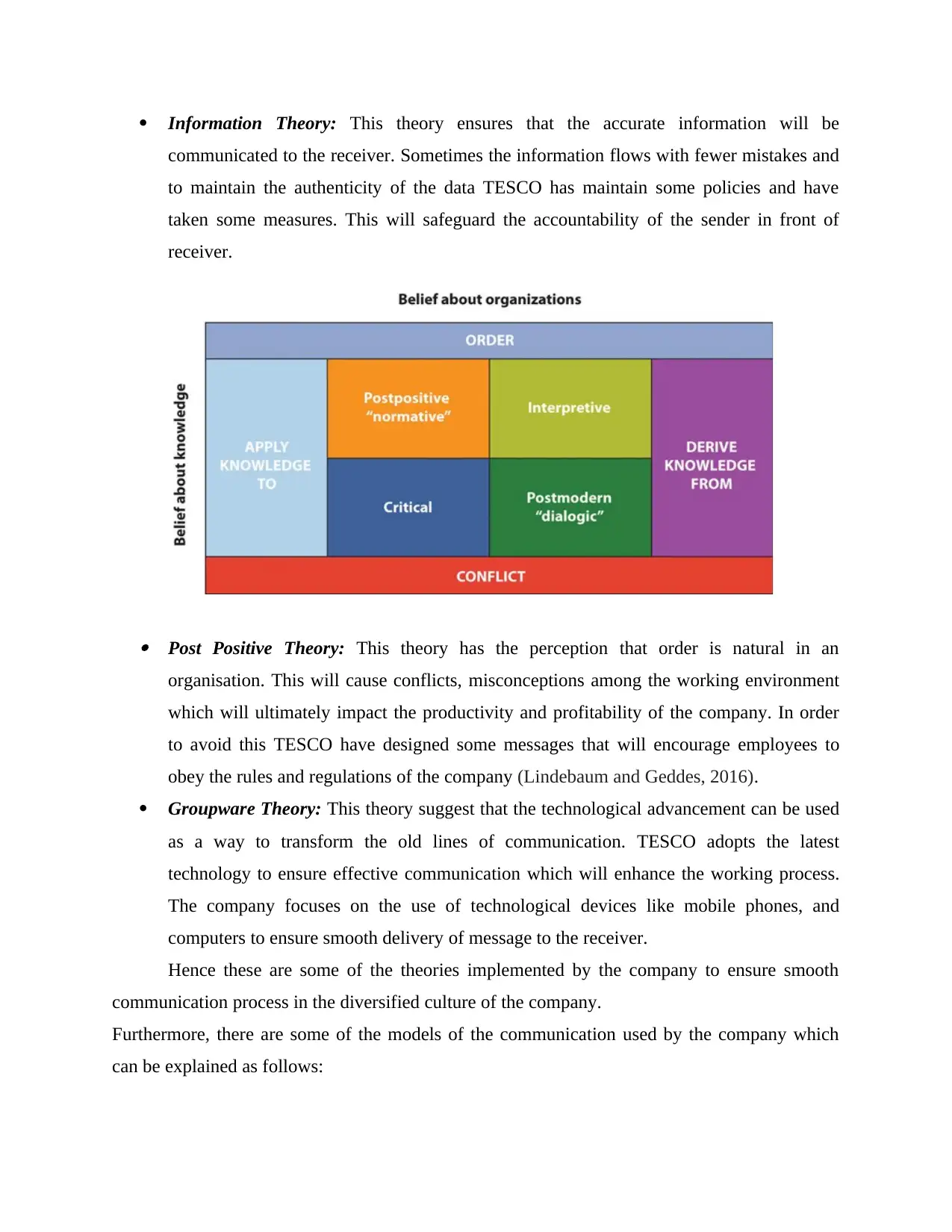
Information Theory: This theory ensures that the accurate information will be
communicated to the receiver. Sometimes the information flows with fewer mistakes and
to maintain the authenticity of the data TESCO has maintain some policies and have
taken some measures. This will safeguard the accountability of the sender in front of
receiver.
Post Positive Theory: This theory has the perception that order is natural in an
organisation. This will cause conflicts, misconceptions among the working environment
which will ultimately impact the productivity and profitability of the company. In order
to avoid this TESCO have designed some messages that will encourage employees to
obey the rules and regulations of the company (Lindebaum and Geddes, 2016).
Groupware Theory: This theory suggest that the technological advancement can be used
as a way to transform the old lines of communication. TESCO adopts the latest
technology to ensure effective communication which will enhance the working process.
The company focuses on the use of technological devices like mobile phones, and
computers to ensure smooth delivery of message to the receiver.
Hence these are some of the theories implemented by the company to ensure smooth
communication process in the diversified culture of the company.
Furthermore, there are some of the models of the communication used by the company which
can be explained as follows:
communicated to the receiver. Sometimes the information flows with fewer mistakes and
to maintain the authenticity of the data TESCO has maintain some policies and have
taken some measures. This will safeguard the accountability of the sender in front of
receiver.
Post Positive Theory: This theory has the perception that order is natural in an
organisation. This will cause conflicts, misconceptions among the working environment
which will ultimately impact the productivity and profitability of the company. In order
to avoid this TESCO have designed some messages that will encourage employees to
obey the rules and regulations of the company (Lindebaum and Geddes, 2016).
Groupware Theory: This theory suggest that the technological advancement can be used
as a way to transform the old lines of communication. TESCO adopts the latest
technology to ensure effective communication which will enhance the working process.
The company focuses on the use of technological devices like mobile phones, and
computers to ensure smooth delivery of message to the receiver.
Hence these are some of the theories implemented by the company to ensure smooth
communication process in the diversified culture of the company.
Furthermore, there are some of the models of the communication used by the company which
can be explained as follows:
Paraphrase This Document
Need a fresh take? Get an instant paraphrase of this document with our AI Paraphraser
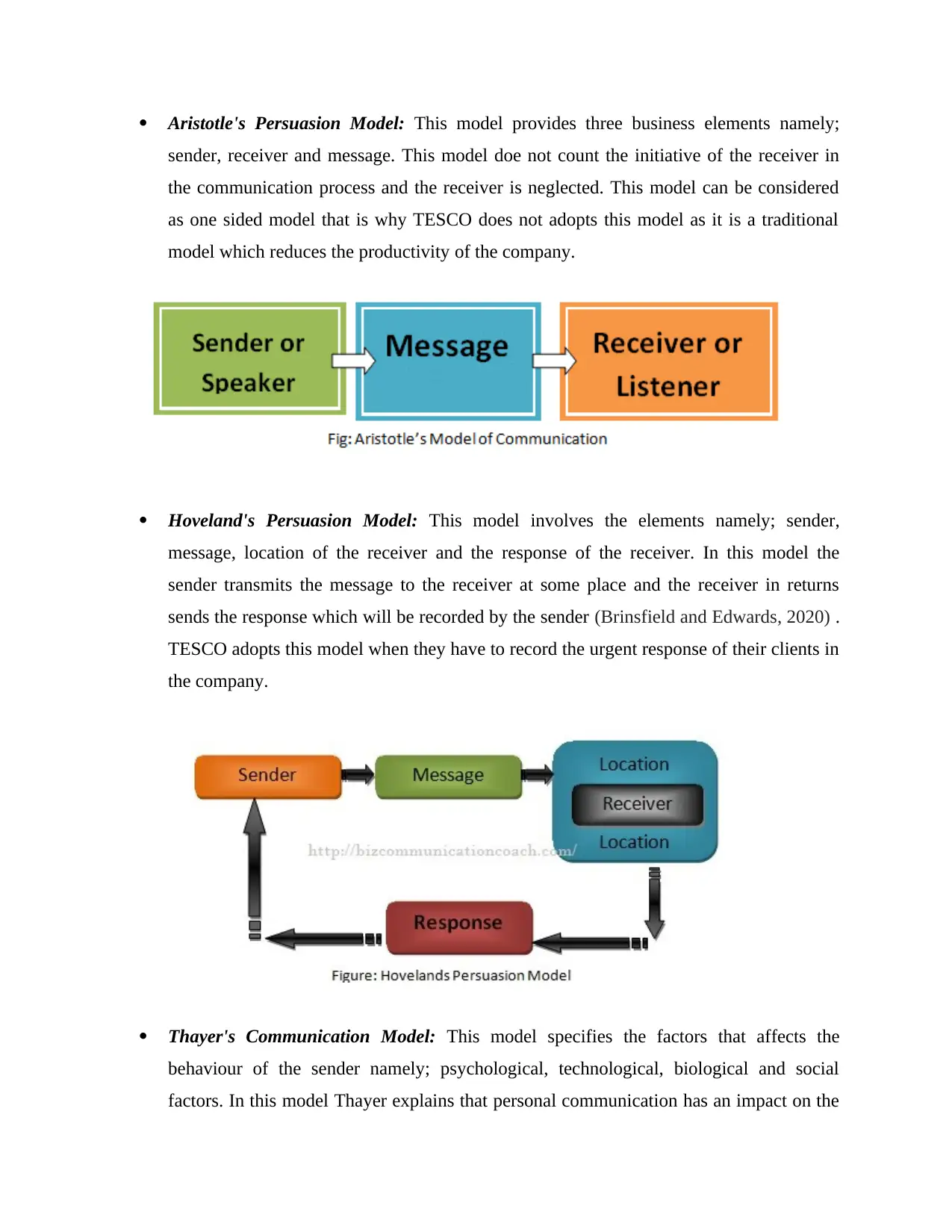
Aristotle's Persuasion Model: This model provides three business elements namely;
sender, receiver and message. This model doe not count the initiative of the receiver in
the communication process and the receiver is neglected. This model can be considered
as one sided model that is why TESCO does not adopts this model as it is a traditional
model which reduces the productivity of the company.
Hoveland's Persuasion Model: This model involves the elements namely; sender,
message, location of the receiver and the response of the receiver. In this model the
sender transmits the message to the receiver at some place and the receiver in returns
sends the response which will be recorded by the sender (Brinsfield and Edwards, 2020) .
TESCO adopts this model when they have to record the urgent response of their clients in
the company.
Thayer's Communication Model: This model specifies the factors that affects the
behaviour of the sender namely; psychological, technological, biological and social
factors. In this model Thayer explains that personal communication has an impact on the
sender, receiver and message. This model doe not count the initiative of the receiver in
the communication process and the receiver is neglected. This model can be considered
as one sided model that is why TESCO does not adopts this model as it is a traditional
model which reduces the productivity of the company.
Hoveland's Persuasion Model: This model involves the elements namely; sender,
message, location of the receiver and the response of the receiver. In this model the
sender transmits the message to the receiver at some place and the receiver in returns
sends the response which will be recorded by the sender (Brinsfield and Edwards, 2020) .
TESCO adopts this model when they have to record the urgent response of their clients in
the company.
Thayer's Communication Model: This model specifies the factors that affects the
behaviour of the sender namely; psychological, technological, biological and social
factors. In this model Thayer explains that personal communication has an impact on the
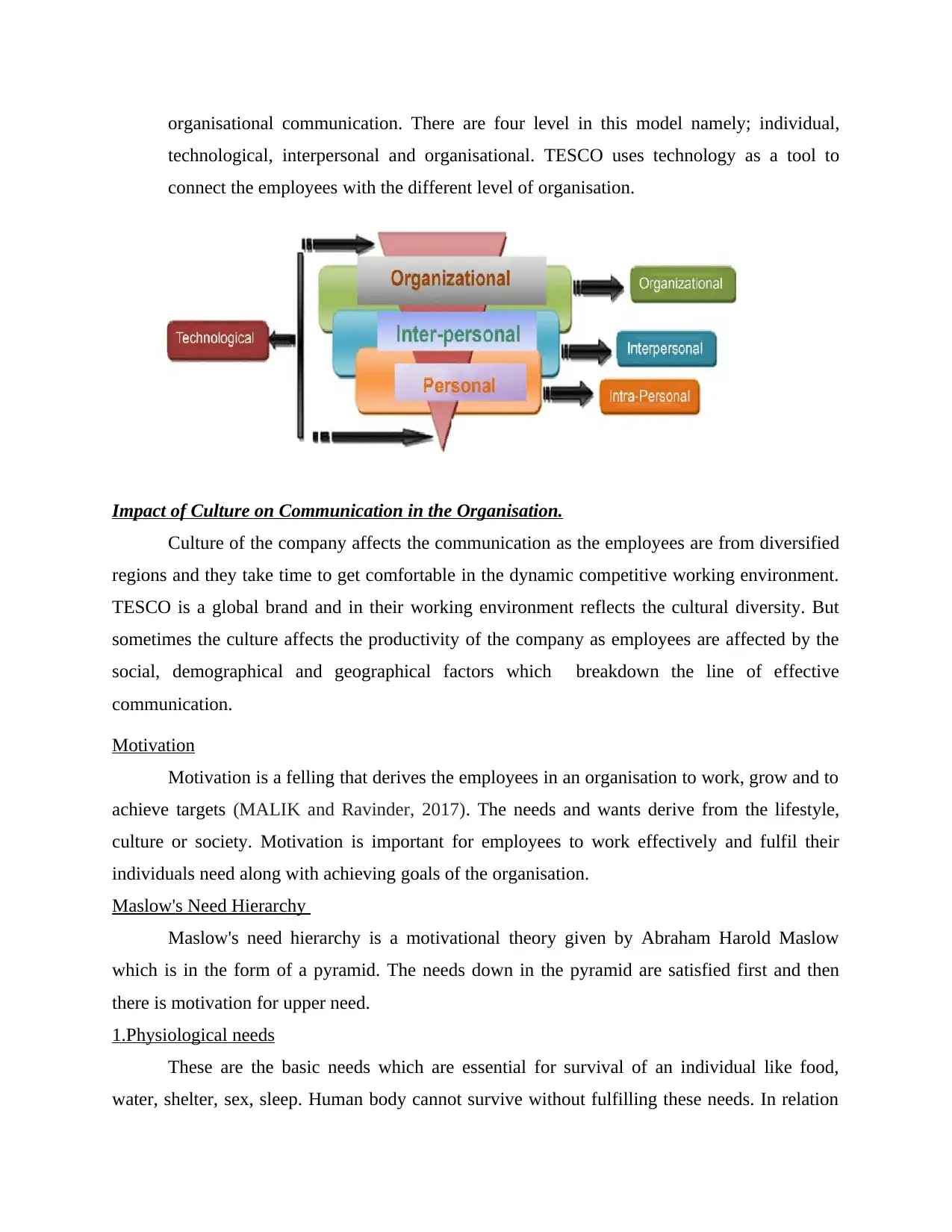
organisational communication. There are four level in this model namely; individual,
technological, interpersonal and organisational. TESCO uses technology as a tool to
connect the employees with the different level of organisation.
Impact of Culture on Communication in the Organisation.
Culture of the company affects the communication as the employees are from diversified
regions and they take time to get comfortable in the dynamic competitive working environment.
TESCO is a global brand and in their working environment reflects the cultural diversity. But
sometimes the culture affects the productivity of the company as employees are affected by the
social, demographical and geographical factors which breakdown the line of effective
communication.
Motivation
Motivation is a felling that derives the employees in an organisation to work, grow and to
achieve targets (MALIK and Ravinder, 2017). The needs and wants derive from the lifestyle,
culture or society. Motivation is important for employees to work effectively and fulfil their
individuals need along with achieving goals of the organisation.
Maslow's Need Hierarchy
Maslow's need hierarchy is a motivational theory given by Abraham Harold Maslow
which is in the form of a pyramid. The needs down in the pyramid are satisfied first and then
there is motivation for upper need.
1.Physiological needs
These are the basic needs which are essential for survival of an individual like food,
water, shelter, sex, sleep. Human body cannot survive without fulfilling these needs. In relation
technological, interpersonal and organisational. TESCO uses technology as a tool to
connect the employees with the different level of organisation.
Impact of Culture on Communication in the Organisation.
Culture of the company affects the communication as the employees are from diversified
regions and they take time to get comfortable in the dynamic competitive working environment.
TESCO is a global brand and in their working environment reflects the cultural diversity. But
sometimes the culture affects the productivity of the company as employees are affected by the
social, demographical and geographical factors which breakdown the line of effective
communication.
Motivation
Motivation is a felling that derives the employees in an organisation to work, grow and to
achieve targets (MALIK and Ravinder, 2017). The needs and wants derive from the lifestyle,
culture or society. Motivation is important for employees to work effectively and fulfil their
individuals need along with achieving goals of the organisation.
Maslow's Need Hierarchy
Maslow's need hierarchy is a motivational theory given by Abraham Harold Maslow
which is in the form of a pyramid. The needs down in the pyramid are satisfied first and then
there is motivation for upper need.
1.Physiological needs
These are the basic needs which are essential for survival of an individual like food,
water, shelter, sex, sleep. Human body cannot survive without fulfilling these needs. In relation
⊘ This is a preview!⊘
Do you want full access?
Subscribe today to unlock all pages.

Trusted by 1+ million students worldwide
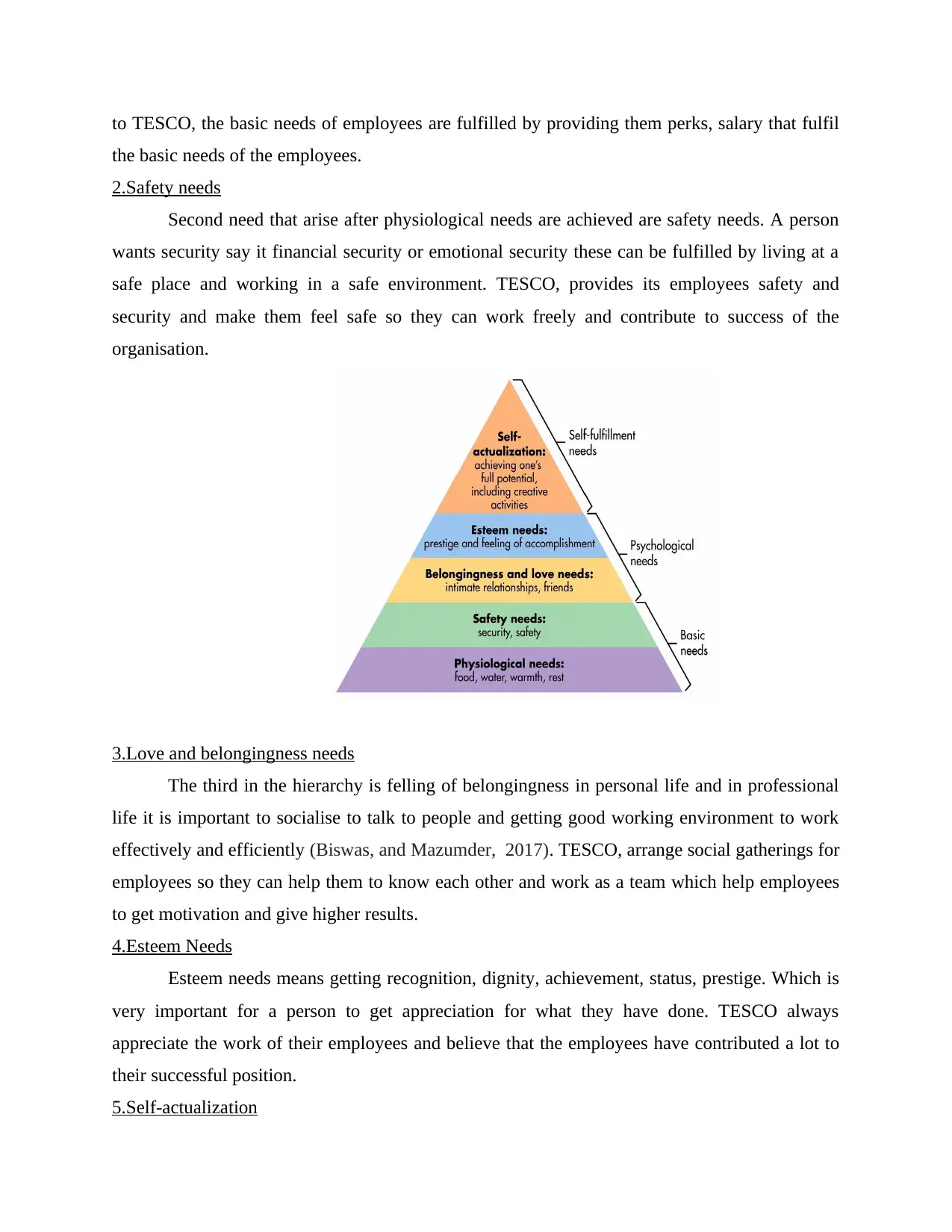
to TESCO, the basic needs of employees are fulfilled by providing them perks, salary that fulfil
the basic needs of the employees.
2.Safety needs
Second need that arise after physiological needs are achieved are safety needs. A person
wants security say it financial security or emotional security these can be fulfilled by living at a
safe place and working in a safe environment. TESCO, provides its employees safety and
security and make them feel safe so they can work freely and contribute to success of the
organisation.
3.Love and belongingness needs
The third in the hierarchy is felling of belongingness in personal life and in professional
life it is important to socialise to talk to people and getting good working environment to work
effectively and efficiently (Biswas, and Mazumder, 2017). TESCO, arrange social gatherings for
employees so they can help them to know each other and work as a team which help employees
to get motivation and give higher results.
4.Esteem Needs
Esteem needs means getting recognition, dignity, achievement, status, prestige. Which is
very important for a person to get appreciation for what they have done. TESCO always
appreciate the work of their employees and believe that the employees have contributed a lot to
their successful position.
5.Self-actualization
the basic needs of the employees.
2.Safety needs
Second need that arise after physiological needs are achieved are safety needs. A person
wants security say it financial security or emotional security these can be fulfilled by living at a
safe place and working in a safe environment. TESCO, provides its employees safety and
security and make them feel safe so they can work freely and contribute to success of the
organisation.
3.Love and belongingness needs
The third in the hierarchy is felling of belongingness in personal life and in professional
life it is important to socialise to talk to people and getting good working environment to work
effectively and efficiently (Biswas, and Mazumder, 2017). TESCO, arrange social gatherings for
employees so they can help them to know each other and work as a team which help employees
to get motivation and give higher results.
4.Esteem Needs
Esteem needs means getting recognition, dignity, achievement, status, prestige. Which is
very important for a person to get appreciation for what they have done. TESCO always
appreciate the work of their employees and believe that the employees have contributed a lot to
their successful position.
5.Self-actualization
Paraphrase This Document
Need a fresh take? Get an instant paraphrase of this document with our AI Paraphraser
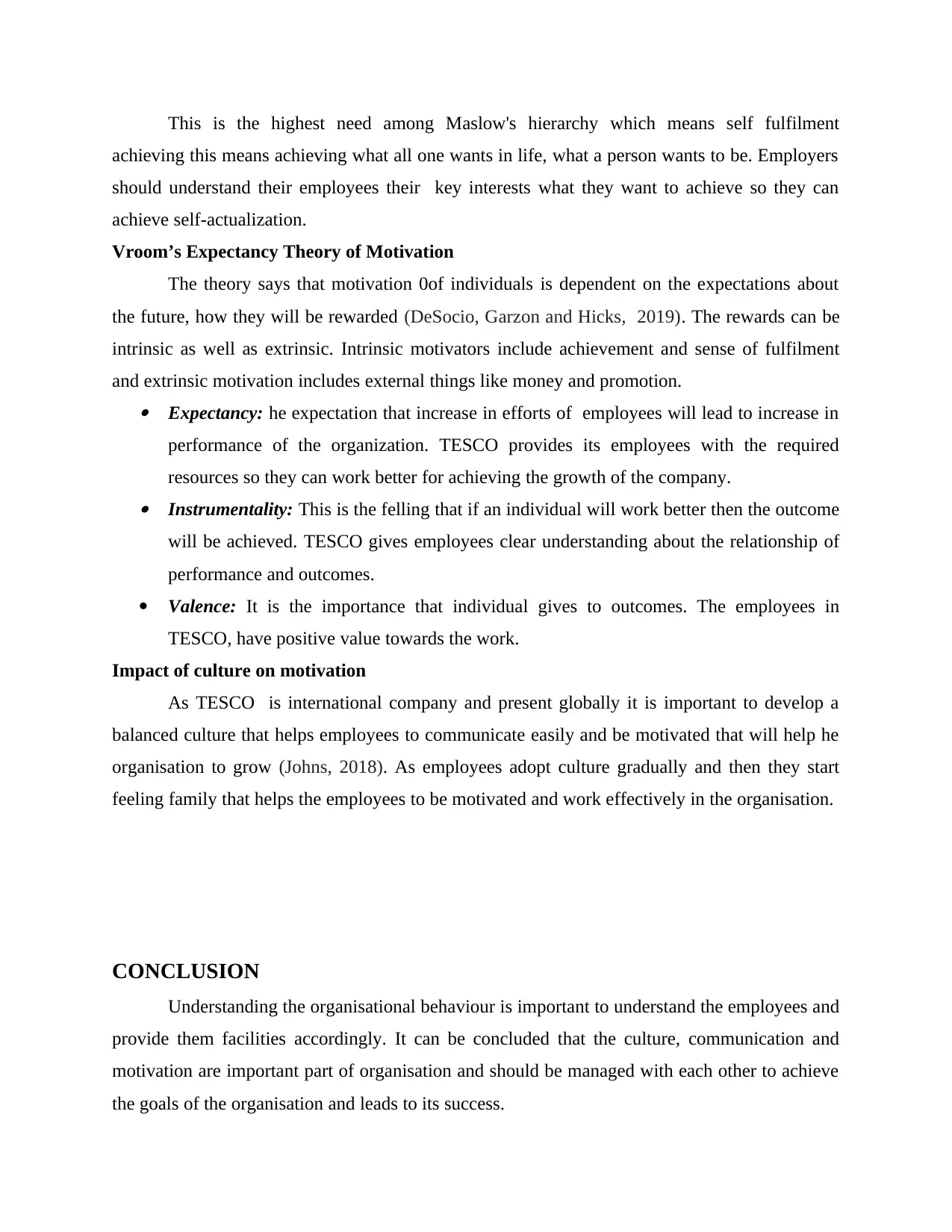
This is the highest need among Maslow's hierarchy which means self fulfilment
achieving this means achieving what all one wants in life, what a person wants to be. Employers
should understand their employees their key interests what they want to achieve so they can
achieve self-actualization.
Vroom’s Expectancy Theory of Motivation
The theory says that motivation 0of individuals is dependent on the expectations about
the future, how they will be rewarded (DeSocio, Garzon and Hicks, 2019). The rewards can be
intrinsic as well as extrinsic. Intrinsic motivators include achievement and sense of fulfilment
and extrinsic motivation includes external things like money and promotion. Expectancy: he expectation that increase in efforts of employees will lead to increase in
performance of the organization. TESCO provides its employees with the required
resources so they can work better for achieving the growth of the company. Instrumentality: This is the felling that if an individual will work better then the outcome
will be achieved. TESCO gives employees clear understanding about the relationship of
performance and outcomes.
Valence: It is the importance that individual gives to outcomes. The employees in
TESCO, have positive value towards the work.
Impact of culture on motivation
As TESCO is international company and present globally it is important to develop a
balanced culture that helps employees to communicate easily and be motivated that will help he
organisation to grow (Johns, 2018). As employees adopt culture gradually and then they start
feeling family that helps the employees to be motivated and work effectively in the organisation.
CONCLUSION
Understanding the organisational behaviour is important to understand the employees and
provide them facilities accordingly. It can be concluded that the culture, communication and
motivation are important part of organisation and should be managed with each other to achieve
the goals of the organisation and leads to its success.
achieving this means achieving what all one wants in life, what a person wants to be. Employers
should understand their employees their key interests what they want to achieve so they can
achieve self-actualization.
Vroom’s Expectancy Theory of Motivation
The theory says that motivation 0of individuals is dependent on the expectations about
the future, how they will be rewarded (DeSocio, Garzon and Hicks, 2019). The rewards can be
intrinsic as well as extrinsic. Intrinsic motivators include achievement and sense of fulfilment
and extrinsic motivation includes external things like money and promotion. Expectancy: he expectation that increase in efforts of employees will lead to increase in
performance of the organization. TESCO provides its employees with the required
resources so they can work better for achieving the growth of the company. Instrumentality: This is the felling that if an individual will work better then the outcome
will be achieved. TESCO gives employees clear understanding about the relationship of
performance and outcomes.
Valence: It is the importance that individual gives to outcomes. The employees in
TESCO, have positive value towards the work.
Impact of culture on motivation
As TESCO is international company and present globally it is important to develop a
balanced culture that helps employees to communicate easily and be motivated that will help he
organisation to grow (Johns, 2018). As employees adopt culture gradually and then they start
feeling family that helps the employees to be motivated and work effectively in the organisation.
CONCLUSION
Understanding the organisational behaviour is important to understand the employees and
provide them facilities accordingly. It can be concluded that the culture, communication and
motivation are important part of organisation and should be managed with each other to achieve
the goals of the organisation and leads to its success.
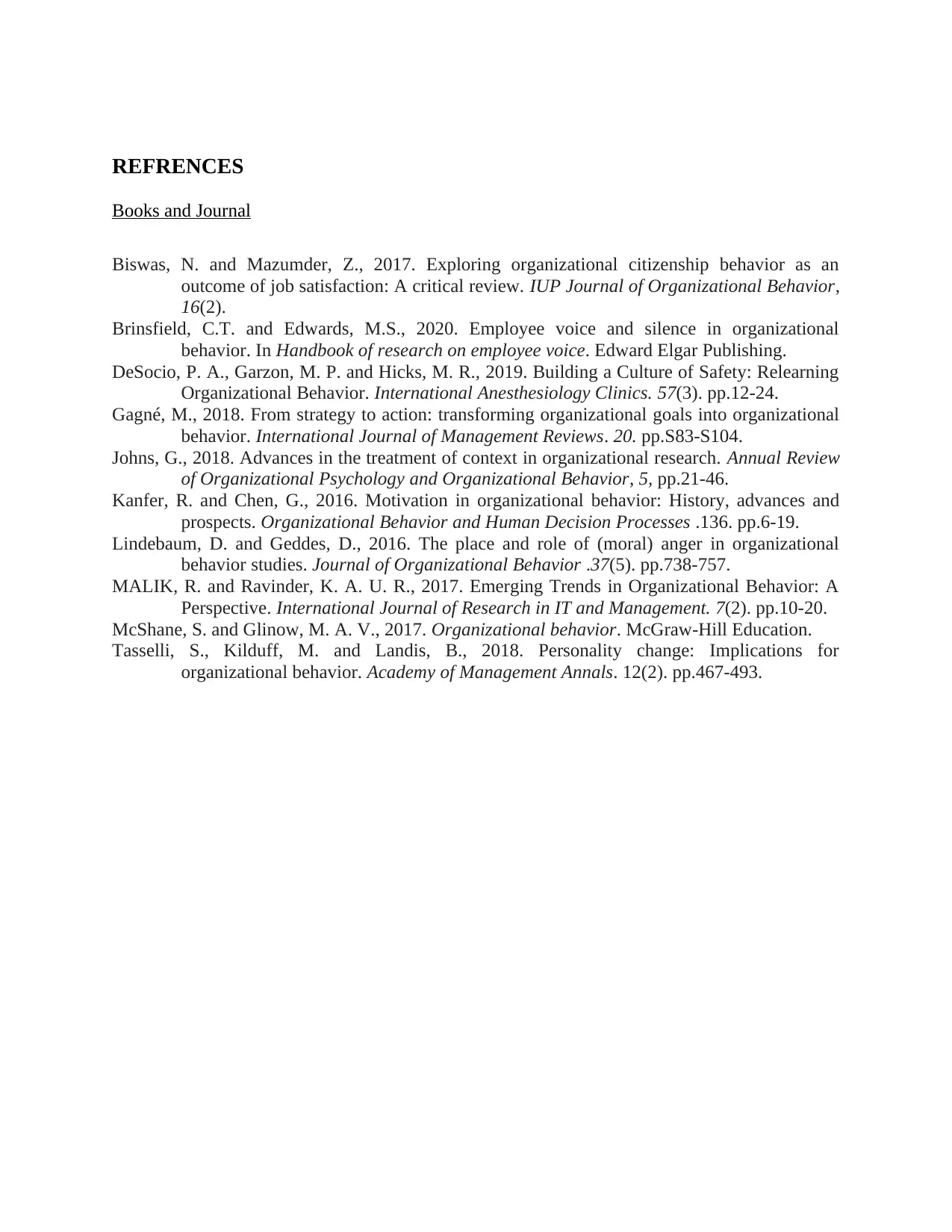
REFRENCES
Books and Journal
Biswas, N. and Mazumder, Z., 2017. Exploring organizational citizenship behavior as an
outcome of job satisfaction: A critical review. IUP Journal of Organizational Behavior,
16(2).
Brinsfield, C.T. and Edwards, M.S., 2020. Employee voice and silence in organizational
behavior. In Handbook of research on employee voice. Edward Elgar Publishing.
DeSocio, P. A., Garzon, M. P. and Hicks, M. R., 2019. Building a Culture of Safety: Relearning
Organizational Behavior. International Anesthesiology Clinics. 57(3). pp.12-24.
Gagné, M., 2018. From strategy to action: transforming organizational goals into organizational
behavior. International Journal of Management Reviews. 20. pp.S83-S104.
Johns, G., 2018. Advances in the treatment of context in organizational research. Annual Review
of Organizational Psychology and Organizational Behavior, 5, pp.21-46.
Kanfer, R. and Chen, G., 2016. Motivation in organizational behavior: History, advances and
prospects. Organizational Behavior and Human Decision Processes .136. pp.6-19.
Lindebaum, D. and Geddes, D., 2016. The place and role of (moral) anger in organizational
behavior studies. Journal of Organizational Behavior .37(5). pp.738-757.
MALIK, R. and Ravinder, K. A. U. R., 2017. Emerging Trends in Organizational Behavior: A
Perspective. International Journal of Research in IT and Management. 7(2). pp.10-20.
McShane, S. and Glinow, M. A. V., 2017. Organizational behavior. McGraw-Hill Education.
Tasselli, S., Kilduff, M. and Landis, B., 2018. Personality change: Implications for
organizational behavior. Academy of Management Annals. 12(2). pp.467-493.
Books and Journal
Biswas, N. and Mazumder, Z., 2017. Exploring organizational citizenship behavior as an
outcome of job satisfaction: A critical review. IUP Journal of Organizational Behavior,
16(2).
Brinsfield, C.T. and Edwards, M.S., 2020. Employee voice and silence in organizational
behavior. In Handbook of research on employee voice. Edward Elgar Publishing.
DeSocio, P. A., Garzon, M. P. and Hicks, M. R., 2019. Building a Culture of Safety: Relearning
Organizational Behavior. International Anesthesiology Clinics. 57(3). pp.12-24.
Gagné, M., 2018. From strategy to action: transforming organizational goals into organizational
behavior. International Journal of Management Reviews. 20. pp.S83-S104.
Johns, G., 2018. Advances in the treatment of context in organizational research. Annual Review
of Organizational Psychology and Organizational Behavior, 5, pp.21-46.
Kanfer, R. and Chen, G., 2016. Motivation in organizational behavior: History, advances and
prospects. Organizational Behavior and Human Decision Processes .136. pp.6-19.
Lindebaum, D. and Geddes, D., 2016. The place and role of (moral) anger in organizational
behavior studies. Journal of Organizational Behavior .37(5). pp.738-757.
MALIK, R. and Ravinder, K. A. U. R., 2017. Emerging Trends in Organizational Behavior: A
Perspective. International Journal of Research in IT and Management. 7(2). pp.10-20.
McShane, S. and Glinow, M. A. V., 2017. Organizational behavior. McGraw-Hill Education.
Tasselli, S., Kilduff, M. and Landis, B., 2018. Personality change: Implications for
organizational behavior. Academy of Management Annals. 12(2). pp.467-493.
⊘ This is a preview!⊘
Do you want full access?
Subscribe today to unlock all pages.

Trusted by 1+ million students worldwide
1 out of 12
Related Documents
Your All-in-One AI-Powered Toolkit for Academic Success.
+13062052269
info@desklib.com
Available 24*7 on WhatsApp / Email
![[object Object]](/_next/static/media/star-bottom.7253800d.svg)
Unlock your academic potential
Copyright © 2020–2025 A2Z Services. All Rights Reserved. Developed and managed by ZUCOL.





